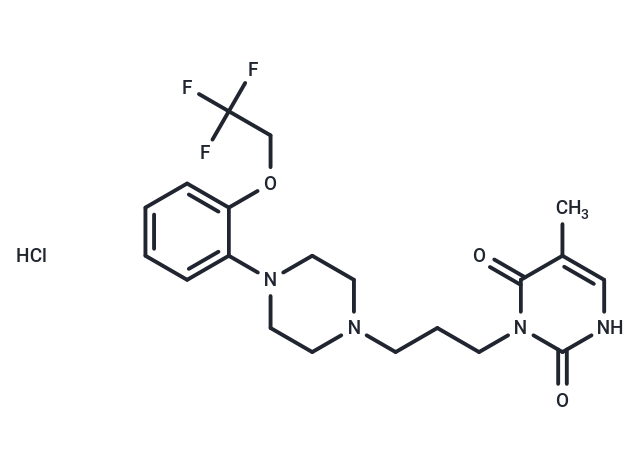Shopping Cart
- Remove All
 Your shopping cart is currently empty
Your shopping cart is currently empty

RS 100329 hydrochloride is an antagonist of α1A-adrenergic receptor.

| Pack Size | Price | Availability | Quantity |
|---|---|---|---|
| 1 mg | $30 | In Stock | |
| 5 mg | $58 | In Stock | |
| 10 mg | $106 | In Stock | |
| 25 mg | $232 | In Stock | |
| 50 mg | $345 | In Stock | |
| 100 mg | $493 | In Stock | |
| 500 mg | Preferential | In Stock |
| Description | RS 100329 hydrochloride is an antagonist of α1A-adrenergic receptor. |
| In vitro | In intact CHO-K1 cells expressing human cloned alpha1A-, alpha1B- and alpha1D-AR showed nanomolar affinity and significant alpha1A-AR subtype selectivity for RS 100329 hydrochloride (pKi 9.6: 126 and 50 fold selectivity) over the alpha1B- and alpha1D-AR subtypes respectively. Noradrenaline-induced contractions of human lower urinary tract (LUT) tissues or rabbit bladder neck were competitively antagonized by RS 100329 hydrochloride (pA2 9.2 and 9.2)[1]. |
| Alias | RS-100329 hcl |
| Molecular Weight | 462.89 |
| Formula | C20H26ClF3N4O3 |
| Cas No. | 1215654-26-4 |
| Smiles | Cl.Cc1c[nH]c(=O)n(CCCN2CCN(CC2)c2ccccc2OCC(F)(F)F)c1=O |
| Relative Density. | no data available |
| Storage | Powder: -20°C for 3 years | In solvent: -80°C for 1 year | Shipping with blue ice. | ||||||||||||||||||||||||||||||
| Solubility Information | H2O: 40 mg/mL (86.41 mM), Sonication is recommended. | ||||||||||||||||||||||||||||||
Solution Preparation Table | |||||||||||||||||||||||||||||||
H2O
| |||||||||||||||||||||||||||||||

Copyright © 2015-2025 TargetMol Chemicals Inc. All Rights Reserved.